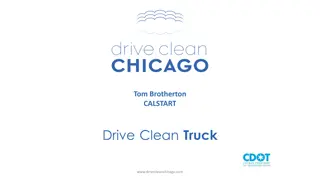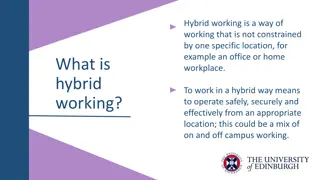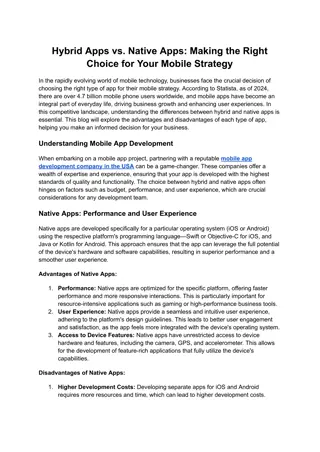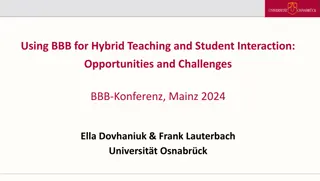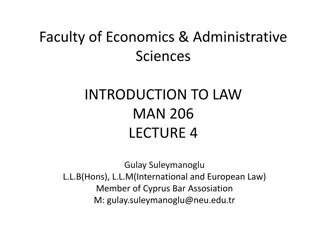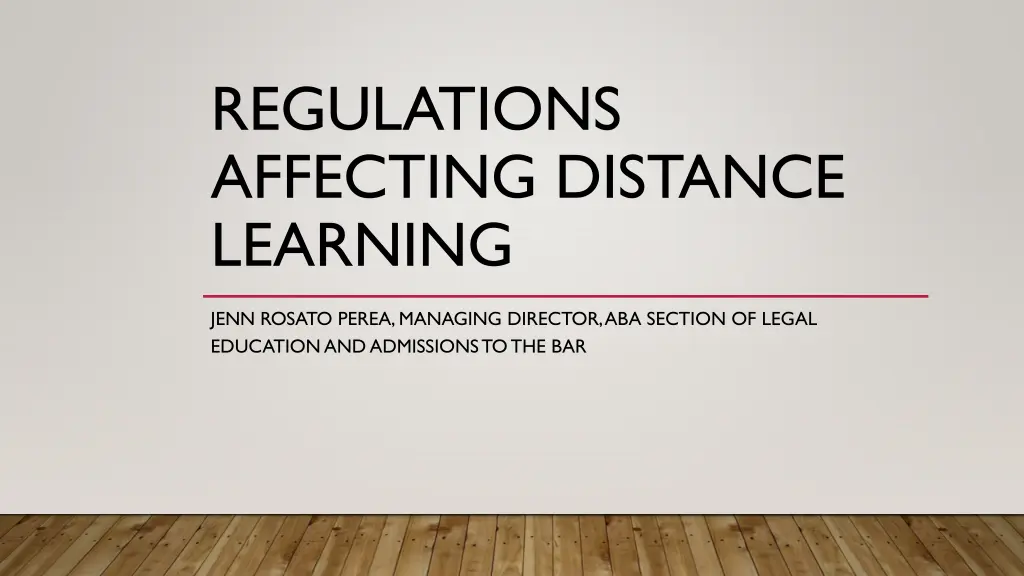
Regulations Impacting Distance Learning in Legal Education
Explore how distance learning regulations have evolved in the legal education sector, from the standards governing credit hours to the thresholds for substantive changes. Learn about the shifts towards online platforms, innovative delivery modes, and the opportunities for change and adaptation in law schools.
Download Presentation

Please find below an Image/Link to download the presentation.
The content on the website is provided AS IS for your information and personal use only. It may not be sold, licensed, or shared on other websites without obtaining consent from the author. If you encounter any issues during the download, it is possible that the publisher has removed the file from their server.
You are allowed to download the files provided on this website for personal or commercial use, subject to the condition that they are used lawfully. All files are the property of their respective owners.
The content on the website is provided AS IS for your information and personal use only. It may not be sold, licensed, or shared on other websites without obtaining consent from the author.
E N D
Presentation Transcript
REGULATIONS AFFECTING DISTANCE LEARNING JENN ROSATO PEREA, MANAGING DIRECTOR, ABA SECTION OF LEGAL EDUCATION AND ADMISSIONS TO THE BAR
A LITTLE BIT ABOUT ME Entered academy in 1990 as legal writing instructor Professor/Associate Dean at Brooklyn Law School Helped launch Drexel s law school Served 16 years as Dean (at three law schools) before becoming managing director A joyful warrior for legal education!
Standards: Standards allowed law students to grant students up to one-third of the credit hours required for the JD degree for Distance Education courses without seeking acquiescence; up to ten credits could be granted during the first one-third of a student s program of legal education. WHERE WE WERE/2018- EARLY2020 Only three on-line programs [of those that currently exist]
WHERE WE WERE All law schools went on-line (in mid-March) 2020 New technology/platforms New modes of delivery (synchronous/asynchronous) Training faculty/staff Individual law school emergency variances for distance ed Silver lining an opportunity for innovation and change in law schools, and Standards to support This Photo by Unknown Author is licensed under CC BY-ND
WHERE WE ARE APPLICABLE DEFINITIONS, STANDARDS, RULES Definition 8 ( Distance Education Course ) Standard 105 (a) (12) (i, ii, iii) and Interpretation 105-1 Acquiescence for Substantive Change in Program or Structure Standard 306 Distance Education Standard 511 -- Verification of Student Identity Rule 24 (a) (12) (i, ii, iii) Application for Acquiescence in Substantive Change
ACQUIESCENCE IN SUBSTANTIVE CHANGE: THREE THRESHOLDS (STANDARD 105(A)(12)) (i) instituting a new full-time or part-time in-person, hybrid, or Distance Education division; (ii) changing academic policies to allow a student to earn 50 percent or more of the credit hours required for the JD degree through Distance Education Courses; or (iii) enrolling 50 percent or more of its students in at least one Distance Education Course or offering 50 percent or more of its courses as Distance Education courses See Interpretation 105-1
WHERE WE ARE DISTANCE ED PROGRAMS 18 programs* https://www.americanbar.org/groups/legal_education/resources/distance_education/approve d-distance-ed-jd-programs/ *Note: one approved program is a specialized prison pipeline program
A SNAPSHOT PROGRAM STARTS: 2019 (3); 2021(3); 2022 (3); 2023 (4); 2024 (5) SIX FULLY ON-LINE (including pipeline program)/REMAINDER HYBRID PART-TIME/FULL-TIME (not including pipeline): [All 18 have part-time programs, 2 have full-time programs] PROGRAM COSTS (STICKER PRICE) RESEMBLE THE RESIDENTIAL PROGRAMS
A SNAPSHOT - DEMOGRAPHICS There have been 2,044 students who are attending or have attended law school through ABA- acquiesced partial or full-time distance education programs based on reporting through the August 2024 Council meeting. 653 of them are students of color (32%) 1,066 of them or 52% are women; 892 or 44% are men and 86 or 4% are another gender identity or chose not to report.
FROM NO RESIDENCY REQUIRED to A SNAPSHOT RANGE OF RESIDENCY REQUIREMENTS PERIODIC RESIDENCIES: to WEEKEND/LONG WEEKEND FOUR DAYS, FIVE DAYS A WEEK RANGE IN FREQUENCY (per year, per program) FIRST- YEAR IN RESIDENCE REQUIRED
A SNAPSHOT OUTCOMES Still early on to predict outcomes since most programs do not yet have graduates Early results comparable between residential and on-line/hybrid programs [and some better] Important to measure consistently and across years: Attrition Dismissals/Probation GPA (1L/cumulative) Graduation rates Post-graduate employment outcomes Bar Passage
WHERE WE ARE GATHERING INFORMATION INITIALLY REPORTING TO ABA IN NARRATIVE FORM IN AQ BEGINNING JANUARY 2025 (BACK TO NORMAL AQ REPORTING CYCLE IN FALL 2025) *CONSISTENCY IN AQ WILL HELP TO COMPARE PROGRAMS, ESPECIALLY ON OUTCOMES *CONSIDER GATHERING DATA ON OTHER HYBRID PROGRAMS THAT DO NOT REQUIRE ACQUIESCENCE?
WHERE WE ARE GOING Continue to take applications for Acquiescence in a substantive change, and continue to gather/analyze data Should the Standards be revised to allow a fully on-line law school? Last year, considered changes to 701 and 702 (earlier in 2024) , which went out for notice and comment [per Strategic Review Committee recommendation/Council adoption], but ultimately were not adopted by the Council On the Standards Committee agenda for this year
THE PROCESS FOR STANDARDS REVISION 1. Standards Committee Makes Proposal to the Council 2. Council Approves for Notice and Comment 3. Notice and Comment Period 4. Standards Committee Makes Proposal to the Council after Comment Review 5. Final Approval by the Council 6. ABA House of Delegates Concurrence Decision This Photo by Unknown Author is licensed under CC BY-NC-ND
CONSIDERATIONS/INFORMATION-GATHERING STAGE Data from current on-line programs still limited, especially in outcomes/ consistency in reporting considering variations in programs Affiliate organization roundtable discussions during August and November council meetings Which standards would need revision to allow a full-on line law school, or would same/similar standards apply? Will existence of fully on-line law schools increase access to justice (e.g., rural deserts) or access to legal education/diversity? Will it decrease the costs of legal education?
DISCUSSION QUESTION: WHAT SHOULD THE COUNCIL CONSIDER AS IT DETERMINES WHETHER TO PERMIT A FULLY ON-LINE LAW SCHOOL?




